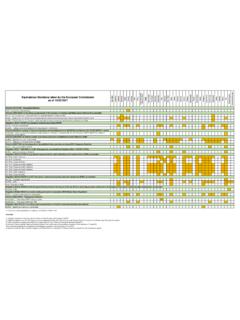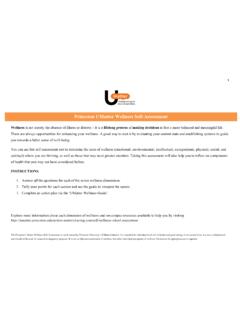Transcription of hedging and invoicing strategies to reduce exchange rate ...
1 EMU@10 Research In May 2008, it will be ten years since the final decision to move to the third and final stage of Economic and Monetary Union (EMU), and the decision on which countries would be the first to introduce the euro. To mark this anniversary, the Commission is undertaking a strategic review of EMU. This paper constitutes part of the research that was either conducted or financed by the Commission as source material for the review. Economic Papers are written by the Staff of the Directorate-General for Economic and financial Affairs, or by experts working in association with them. The Papers are intended to increase awareness of the technical work being done by staff and to seek comments and suggestions for further analysis.
2 The views expressed are the author s alone and do not necessarily correspond to those of the European Commission. Comments and enquiries should be addressed to: European Commission Directorate-General for Economic and financial Affairs Publications B-1049 Brussels Belgium E-mail: This paper exists in English only and can be downloaded from the website A great deal of additional information is available on the Internet. It can be accessed through the Europa server ( ) Brussels: Office for Infrastructures and Logistics in Brussels, 2008 ISBN 978-92-79-08224-5 doi: European Communities, 2008 hedging and invoicing strategies to reduce exchange rate exposure: a euro-area perspective 1Bj rn D hring European Commission DG ECFIN January 2008 Abstract Domestic-currency invoicing and hedging allow internationally active firms to reduce their exposure to exchange rate variations.
3 This paper discusses exchange rate exposure in terms of transaction risk (the risk of variations of the value of committed future cash flows), translation risk (the risk of variations of the value of assets and liabilities denominated in foreign currency) and broader economic risk (which takes into account the impact of exchange rate variations on competitiveness). The paper argues that domestic-currency invoicing and hedging with exchange rate derivatives allow a fairly straightforward management of transaction and translation risk and discusses under which circumstances their use is optimal.
4 Economic risk is by its very nature harder to manage, but the paper argues that natural hedging provides possibilities for doing so. The discussion of management techniques for exchange rate exposure is complemented with an analysis of their actual use. This draws on data on the invoicing currencies of euro-area exports and on previous empirical work on hedging , which has, however, focussed largely on firms in the US and a small number of EU Member States. A novelty of this paper is a survey of actual hedging strategies and techniques of large corporations from a euro-area perspective.
5 The paper finds that euro-area exporters have instruments at hand to limit the adverse impact of euro appreciation and that they make ample use of them. Key words: exchange rate risk, invoicing currency, hedging , derivatives JEL classification: F23, F31, G32 1 The views expressed in this paper are those of the author and should not be interpreted as those of the European Commission or of the Directorate-General for Economic and financial Affairs. The author gratefully acknowledges helpful comments by S. Deroose, M.
6 Suardi and E. Ruscher. All remaining errors are the author's. 1 Introduction As the euro exchange rate to the US dollar reached new record highs in the summer and autumn of 2007, concerns about the impact of the appreciation on euro-area exports have been voiced in the media. Earlier in 2007, then Airbus chairman Gallois famously estimated that a euro appreciation of 10 cent against the US dollar cost his company one billion euro due to the fact that a large share of the company's costs are denominated in euro, whereas the bulk of its revenues is in US dollar.
7 Previous analysis ( in European Commission, 2007) argued that euro-area exports have held up well to the euro appreciation in recent years, as strong world demand more than compensated the negative impact of the appreciation on exports. Moreover, in real effective terms, the appreciation has not been as strong as the bilateral exchange rate of the euro against the US dollar suggests. This paper focuses on how euro-area exporting firms can (and do) protect themselves against exchange rate risk through euro invoicing and hedging and discusses interactions between domestic-currency invoicing and hedging .
8 While the focus of this paper is on the implication of exchange rate risk for exporting firms, differences between (net) exporters and (net) importers are briefly discussed where relevant. When exports are invoiced in domestic currency, the (short-term) exchange rate risk is borne by the importer rather than by the exporter. This paper draws on the literature to consider under which conditions such a shifting of the risk is possible and optimal for the exporting firm and then assesses the actual use of euro invoicing by euro-area exporters, based on data collected by the ECB.
9 exchange rate risk can also be neutralised ("hedged") through financial instruments, such as exchange rate derivatives or foreign currency debt ( financial hedges), as well as through the operational setup of the exporting firm (operational hedges). financial derivatives have today become standard tools for hedging risks related to exchange rates , interest rates or commodities prices. This paper discusses hedging instruments and hedge design and surveys the literature on the use of hedging . For the US, the use of hedging strategies and instruments is empirically well documented.
10 Other studies have covered firms in individual European countries, but to the author's knowledge, none has so far taken a euro-area perspective. This paper contributes to closing that gap through a survey of self-reported hedging strategies and instruments of euro-area blue chip companies. While the approach of this paper is microeconomic, there are macroeconomic consequences of firms' hedging and invoicing strategies . These concern the impact of exchange rate variations on the trade balance2 or the international role of the euro,3 which are not discussed here.













